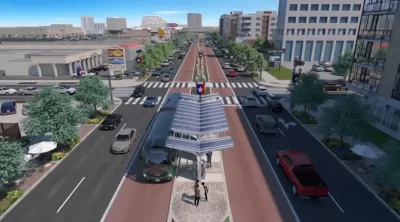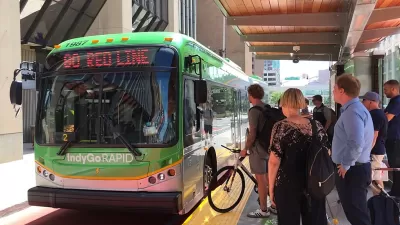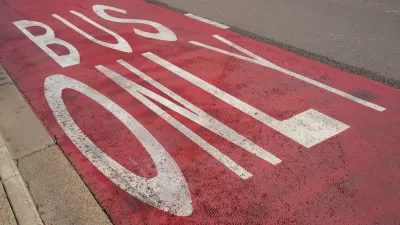A new bus line will bring some of the benefits of bus rapid transit, connecting the city’s airport and downtown.

An article by Andrea Drusch in the San Antonio Report describes how a future Advanced Rapid Transit (ART) line will operate once it opens in 2027.
The north-south Green Line is part of VIA Metropolitan Transit’s plans to bring more rapid transit to San Antonio and will connect the international airport to the city’s downtown and colonial-era missions.
“The first segment was made possible by a windfall of pandemic relief money for VIA, combined with a voter-approved one-eighth-cent sales tax for transit that starts in 2026. The agency has used some of its $270 million in pandemic relief to move the project along before the tax increment funding kicks in, while the approval of a local match allowed VIA to leverage federal money for the rest.”
The line will have dedicated center lanes in some areas and will pick up passengers from the outermost traffic lanes in others. “To reduce stop times, riders are expected to pay for the fare in advance, possibly by mobile app. No ticket will be required to board. Raised boarding platforms also will minimize stop times, allowing buses to run at more frequent, predictable intervals.” The project also includes funding for new sidewalks and pedestrian crossing improvements.
The project is hindered by conflict with the Texas Department of Transportation (TxDOT), Drusch adds. “Notably, the Green Line buses must run alongside regular traffic when passing under highways, where the state retains the right-of-way.”
FULL STORY: Hop on the Green Line: How VIA’s new rapid bus route will operate

Study: Maui’s Plan to Convert Vacation Rentals to Long-Term Housing Could Cause Nearly $1 Billion Economic Loss
The plan would reduce visitor accommodation by 25,% resulting in 1,900 jobs lost.

North Texas Transit Leaders Tout Benefits of TOD for Growing Region
At a summit focused on transit-oriented development, policymakers discussed how North Texas’ expanded light rail system can serve as a tool for economic growth.

Why Should We Subsidize Public Transportation?
Many public transit agencies face financial stress due to rising costs, declining fare revenue, and declining subsidies. Transit advocates must provide a strong business case for increasing public transit funding.

How to Make US Trains Faster
Changes to boarding platforms and a switch to electric trains could improve U.S. passenger rail service without the added cost of high-speed rail.

Columbia’s Revitalized ‘Loop’ Is a Hub for Local Entrepreneurs
A focus on small businesses is helping a commercial corridor in Columbia, Missouri thrive.

Invasive Insect Threatens Minnesota’s Ash Forests
The Emerald Ash Borer is a rapidly spreading invasive pest threatening Minnesota’s ash trees, and homeowners are encouraged to plant diverse replacement species, avoid moving ash firewood, and monitor for signs of infestation.
Urban Design for Planners 1: Software Tools
This six-course series explores essential urban design concepts using open source software and equips planners with the tools they need to participate fully in the urban design process.
Planning for Universal Design
Learn the tools for implementing Universal Design in planning regulations.
Ascent Environmental
Borough of Carlisle
Institute for Housing and Urban Development Studies (IHS)
City of Grandview
Harvard GSD Executive Education
Toledo-Lucas County Plan Commissions
Salt Lake City
NYU Wagner Graduate School of Public Service





























